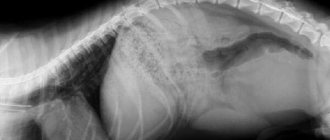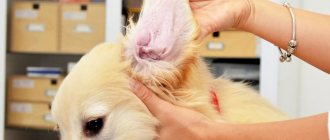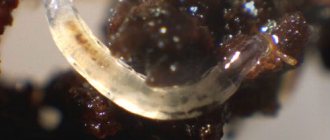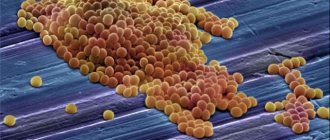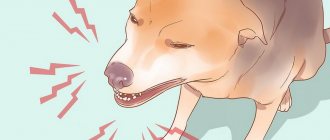Veterinary statistics say that every fifth four-legged pet suffers from diseases that affect the ears. At the slightest manifestation of symptoms of the disease, it is necessary to consult a veterinarian for help, especially if the owner has discovered brown discharge from the dog’s ears.
To make a correct diagnosis and prescribe adequate treatment, it is necessary to conduct research and a thorough examination of the pet by a specialist. It is not recommended to self-medicate, as this may make it difficult for your veterinarian to make a diagnosis.
Ear mite
Gray plaque in a dog’s ears is a specific symptom of otodectosis. This disease develops due to the penetration of a microscopic mite into the ear canal. In response to the waste products of the parasite, inflammation begins. Symptoms of the disease:
- Gray exudate.
- Brown dense coating and crusts.
- Redness of the skin of the ear.
- General malaise of the pet.
When a tick occurs, the dog's behavior changes. The pet becomes restless, often shakes its head and scratches its ears. The pet's appetite worsens and weight loss may occur. In older animals, otodectosis is accompanied by symptoms of general malaise - lethargy, drowsiness, and fever.
The disease must be treated promptly. Otherwise, there is a risk of perforating the eardrum, which can lead to hearing impairment.
For treatment, special drops for cleaning the ears (“Bars”) and broad-spectrum antiseptic and antibacterial agents are used. The diagnosis is made based on the analysis of dense discharge.
Diseases associated with discharge from the ears and their treatment
If characteristic signs of otitis media in dogs or ear mite infestation appear, it is important to promptly consult a veterinarian for help.
Based on the research results, the specialist will prescribe the most appropriate treatment, taking into account the individual characteristics of the pet’s body. Making a diagnosis involves collecting an anamnesis, including determining the seasonality of the onset of otitis media and changes in diet. Next, the doctor conducts a physical examination, otoscopy, and examination of the skin of the pet’s entire body. Brown discharge from a dog's ears can be dry or wet.
In the first case, the nature of the discharge indicates an ear mite, and moist brown discharge is evidence of the development of a staphylococcal infection or yeast fungi.
When making a diagnosis, it is mandatory to collect biological material - fluid in the dog’s ear for further laboratory research. This is necessary to determine the presence or absence of pathogenic bacterial or fungal microflora, as well as the degree of sensitivity to various medications. It is also recommended to take a blood test to determine the patient’s general and allergic condition.
Once the diagnosis is made, the veterinarian prescribes appropriate treatment. When treating ear mites, medications are prescribed in the form of drops instilled into both ear canals of the dog, regardless of the degree of damage. The specialist prescribes an individual dosage based on the age and health of the pet. The most common medications are:
- Amitrazine;
- Otovedin;
- Tsipam;
- Leopard.
In order to cure otodectosis in a pet, an integrated approach using ointments is necessary. Together with the drops, ointments are used for external treatment, pre-warmed to +18 degrees. The most commonly used ointments are Oridermil, sulfur ointment, aversictin ointment, Amidel-gel. Ointments help eliminate adult ear mites, but do not destroy the larval stage. That is why it is recommended to re-treat with special ointments 7-10 days after the initial treatments.
The occurrence of otitis in dogs as a result of an allergic reaction requires a completely different approach - first of all, it is necessary to identify the main provoking factor.
Treatment of allergic otitis media includes taking corticosteroid medications to eliminate the inflammatory process and reduce pain.
Often, to prevent secondary infection with bacterial pathogenic microflora, antimicrobial drugs are included in the course of treatment. In the initial stages of allergic otitis in dogs, medications are widely used that block the excessive production of histamines - Tavegil, Suprastin, Diacholin, which relieve itching, eliminate swelling and hyperemia.
In case of fungal infection of the ear canals, it is necessary to determine what caused the decrease in the body’s immune forces and the activation of fungal microflora. Otherwise, the treatment will not give positive results, and fungal otitis media will appear in the dog again.
For the treatment of otitis of fungal etiology, antimycotic medications are widely used - Oricin, Tresaderm in combination with antimicrobials - Ceftriaxone and Gentamicin.
Treatment of bacterial otitis involves taking antibiotics and immune-modulating agents. A course of antimicrobial agents for purulent otitis allows not only to eliminate the causative agents of the disease, but also to relieve inflammation in the organ and prevent the development of otitis of the middle and inner ear.
Therapy should be prescribed exclusively by a veterinarian. Self-administration of medications purchased at a pharmacy without consultation with a specialist can cause serious complications, which will delay the recovery process as a result of a blurred pattern of manifestations.
Possible complications
The first thing that untreated otitis media will lead to is a sharp decrease in immunity. In turn, this can provoke the penetration of various parasites and other pests into the animal’s body, which contribute to the development of more severe pathologies.
But problems with immunity are the simplest complication. If left untreated, the following pathologies may appear:
- inappropriate behavior that can lead to the pet being unable to live among people;
- destruction of surrounding tissues;
- serious damage to the eardrum, which leads to complex and irreversible consequences;
- deafness that cannot be treated;
- torticollis, which occurs due to the fact that the pet sits for a long time with its head tilted strongly;
- serious damage to the nervous system. It manifests itself like this: the pet cannot walk normally, its movements become uncoordinated, the animal does not notice objects and people, as a result of which it bumps into them;
- The most difficult lesion resulting from otitis media is coma. As practice shows, the dog has virtually no chance of getting out of it.
To avoid this, you need to start treatment on time, and even better, take preventive measures.
Rules for cleaning ears
You should not overdo it in caring for your pet’s ears or removing wax unnecessarily. It performs protective functions, has antibacterial properties, and prevents the development of infection. A simple test can help determine whether cleaning is required. Use sticks or swabs soaked in special preparations to wipe the area near the ear openings. If there is a small amount of yellowish plaque left on them, the sink is pink, and there is no dirt on it, no cleaning is required. There are several reasons for performing cleansing procedures:
- the presence of accumulations of dark sulfur;
- contaminants on the skin of shells;
- sulfur plug;
- hairs clogging the passages.
If sulfur plugs have formed, the pet feels discomfort. Usually in these cases he shakes his head after waking up. You need to drop a little lotion into your ears and lightly massage the shells from the outside. This stimulates the release of plugs.
You need to pay special attention to your dog's ears during the warm season. During walks, insects and mites can get into shells and passages from plants. They must be removed immediately using tweezers.
When infectious or inflammatory diseases of the ears appear, the pet shakes its head and does not allow touching the ears. In such cases, it is necessary to take the dog to the veterinarian, determine the type of disease, and receive recommendations for its treatment.
Signs of a dog's hearing organ disease
A red ear inside a dog is the first sign of illness in the animal’s hearing organs. If the dog shakes its head, lowers it to its side, constantly scratches the parotid area, there is abundant sulfur discharge accompanied by an unpleasant odor, and the ear itself “squelches”, and, on top of everything else, the pet behaves nervously, eats and sleeps poorly, then there is fact of animal ear disease.
The signs of canine ear diseases are similar to each other, so it is not advisable to self-medicate, but it is better to seek help from a veterinarian who will make an accurate diagnosis and prescribe the necessary treatment.
Diagnostics
You cannot be treated for any disease without an accurate diagnosis. Many pet owners are confident that they will be able to spot otitis media and prescribe treatment for their pet based on their knowledge. The fact is that this pathology cannot be seen with the naked eye. Therefore, the presence of the disease can be assumed only based on the clinical picture.
To confirm or refute the diagnosis, a sample taken by a veterinarian from the dog's ear is examined. Additional diagnostic measures may be prescribed at the discretion of the doctor.
Preventative ear examinations
The risk group includes pets with floppy ears. Most susceptible to infectious diseases:
- basset hounds,
- spaniels,
- beagles
There are dog breeds with erect ears that also require special attention. These, for example, include schnauzers, which are prone to inflammatory diseases of the hearing organs.
The main preventive measure is regular inspections of sinks. It is advisable to accustom pets to this procedure from a very early age. This will allow you to carry out examinations calmly without disturbing the dog. Droopy ears should be inspected every day. For pets of breeds that are not at risk, two to three procedures per month are sufficient.
When checking, you need to pay attention to the shade of sulfur and its amount. The appearance of a focus of infection is accompanied by an unpleasant odor. If it is detected, it should be treated with special preparations. It is necessary to clean the ears. But excessive efforts in this procedure can also cause violations. If sulfur is removed too often, its production process is activated. Earwax plugs will appear, blocking the ear canal. If the examination does not reveal excesses of this protective substance, there is no need to clean your ears.
During walks, sinks may become dirty. To remove dust and dirt, special products are used that are sold in veterinary clinics and pet stores. You need to wrap cotton wool around your finger, moisten it in the solution, and gently wipe the ears. Tampons should be changed until the sinks are completely clean. You can use cotton swabs with large heads intended for infants in the procedure.
What to do at home
In parallel with drug therapy, it is necessary to follow the following rules at home:
- regularly treat affected areas with a solution of chlorhexidine or myromistin;
- Do not put too much pressure on the dog’s ears;
- use exudate solution - a special product that can be used to clean wax from your ears;
- use douching with saline to clear clogged ears;
- It is regularly necessary to bury your pet’s ears with drops prescribed by your veterinarian;
- After treatment with drops, you need to lightly massage the ear. If the disease does not go away, it is necessary to change medications.
In some cases, it is recommended to use drying ointments daily. You should not prescribe it to your dog yourself.
Prevention
Main types of preventive measures:
- Daily examination and observation of the dog’s behavior;
- Treatment once every 4 weeks for blood-sucking parasites, once every 3 months for helminths;
- Reduce the number of contacts with potentially sick dogs and their habitats;
- Treatment with an acaricidal preparation or purchasing a special collar with an acaricide. It is valid for 3-6 months.
Over the course of a year, every owner may encounter such a problem, so everyone needs to know the treatment regimen and use of drugs.
How to treat
There are enough drugs that treat otodectosis in any veterinary pharmacy. All of them are developed on the basis of acaricides. Some drugs contain painkillers and other components, but cost on average 2-3 times less.
Below is a list of the most effective and frequently used drugs.
- Unoiled. The price is about 20 rubles. For 200 ml of water, 1 ml of the drug is needed. The resulting solution is used to treat the ears and areas around them. After 7 days you need to repeat the procedure.
- "Aversictin" ointment. Price - about 60 rubles. Lubricate the ears every 3-5 days. Complete recovery requires 2-7 procedures.
- gel "Amidel NEO". The cost is about 180 rubles. From 0.5 to 2 g of gel is injected with a special dispenser syringe, and then the ears folded in half are massaged. Repeat the procedure 1-2 times. Frequency 3-5 days.
- gel "Ivermec". The cost is about 400 rubles. Lubricate treated and clean ears generously. Repeat after a week. The gel accelerates healing and has an analgesic effect.
- Bars drops. The price is about 150 rubles. Twice after 5-7 days, drop a certain number of drops into each ear. For small dogs - 3 drops, medium - 4, large - 5.
- Amitrazine drops. The cost is about 90 rubles. Small dogs are given 0.5 ml, medium dogs 1 ml, large dogs 1.5-2 ml. The standard interval between procedures is 5-7 days. An average of 2-6 procedures are required.
- Dekta Forte drops. The average price is 110 rubles. Place 3 to 5 drops into each ear. Massage at the base of the ear. It is necessary to carry out 2-3 procedures every 3-5 days. The composition includes chloramphenicol, propolis and lidocaine.
- Tsipam drops. The cost is about 200 rubles. The ears are wiped with a swab dipped in Tsipam. Then, depending on the weight of the dog, 3-6 drops are instilled.
- spray "Acaromectin". The price is about 150 rubles. Spray the ears generously. Process 1-2 times. The second procedure is carried out after 8-10 days.
- "Decor-2". The average cost is 70 rubles. The drug burns, before use you should treat the skin with vegetable oil. Then apply the preparation with a sponge. After a week, repeat the operation.
This is the main list of drugs. It is important to remember that they should not be used for infections, low weight, pregnancy, and also not to be used when treating 1-2 month old puppies.
At-risk groups
All dogs, without exception, have a risk of infection. However, there are age groups and certain breeds that are more predisposed to the disease. Most often, puppies and juniors 1.5-6 months old are affected. Long-eared dog breeds have a higher vulnerability. Hunting dogs become infected during hunting from wild animals.
Ear mites are not exclusively a dog disease; they can be transmitted to other animals. If you have other pets, they should be isolated while the sick dog is being treated.
Main routes of infection
The tick is unstable in the external environment. It can live a maximum of 3 weeks at a temperature of 10 to 20 degrees Celsius. At temperatures below -5 degrees, the parasite will live no more than 3-5 hours.
The probability of infection is high and does not depend on climatic factors. Living on the body of an animal, parasites are in optimal conditions for themselves in any weather. There are two main routes of infection – contact and household. If everything is clear with the first, then the second has a more extensive base. This includes a bed, food utensils, care items, and the owner’s clothing if he has been in contact with an infected dog. You should adhere to the principle of “individual and hygienic” use of dog care items.
Periods of active infection usually occur in early spring and late autumn.
How to treat external and otitis media
If you notice signs of ear disease in your pet, rush to see a doctor for help. Do not try to experiment with antibiotics on your own, especially since a number of the drugs mentioned have an ototoxic effect.
To treat external otitis, the ears are cleaned. This can be done using cotton pads, swabs, special tampons and napkins. It is permissible to treat the ears with hydrogen peroxide, petroleum jelly or special lotions for the care of dog ears. The auricle is thoroughly cleaned with hydrogen peroxide until the skin is pink, wax, exfoliated epithelial cells and hairs are removed from the ear canal.
To treat otitis, the veterinarian prescribes antibacterial drugs, antiallergic drugs, and glucocorticoids, which have a pronounced anti-inflammatory and antiallergic effect. The drugs Aurizon and Oridermil have a good effect on the condition of the auricle.
If the inflammatory process is caused by mites entering the ear, you can try home treatment. Place a few drops of sunflower oil into each ear. The course of treatment will be at least three weeks.



